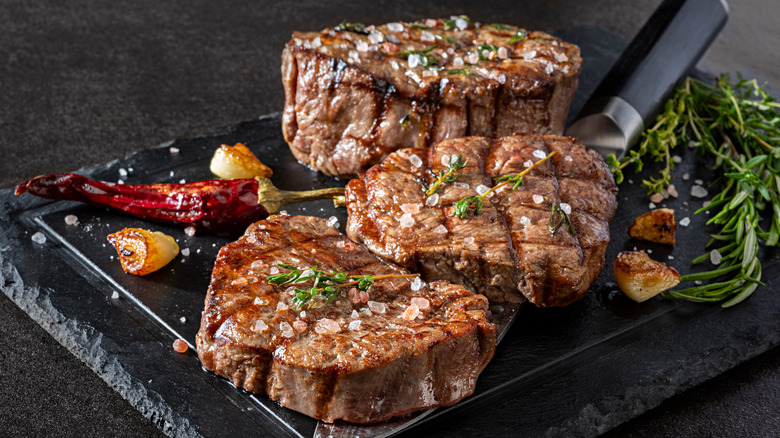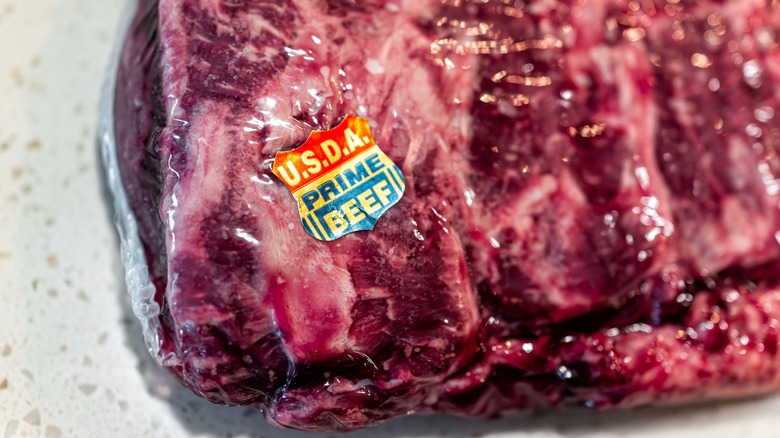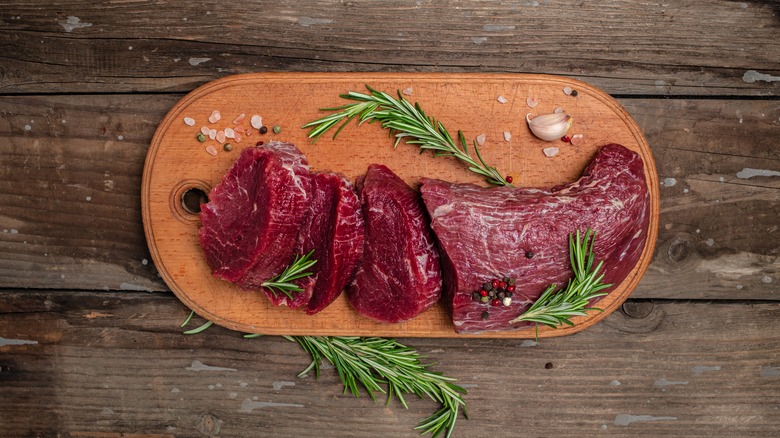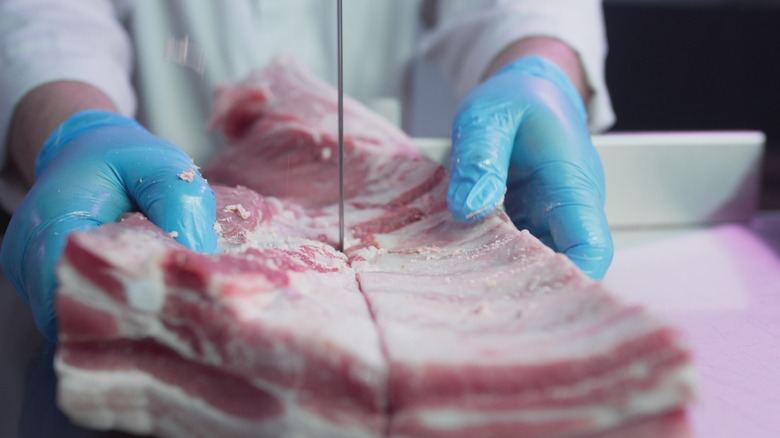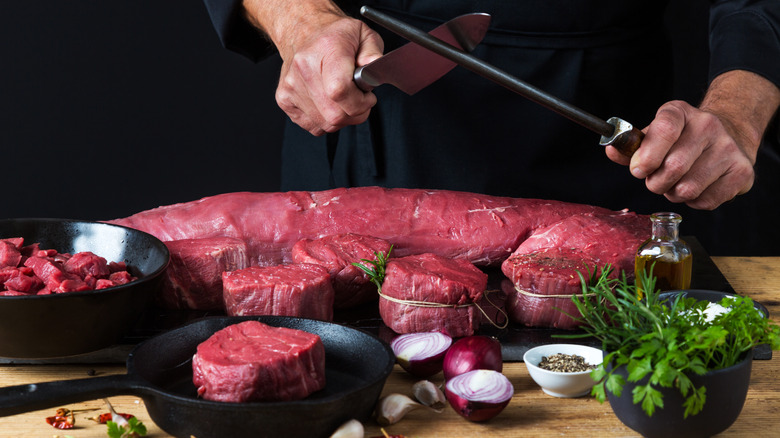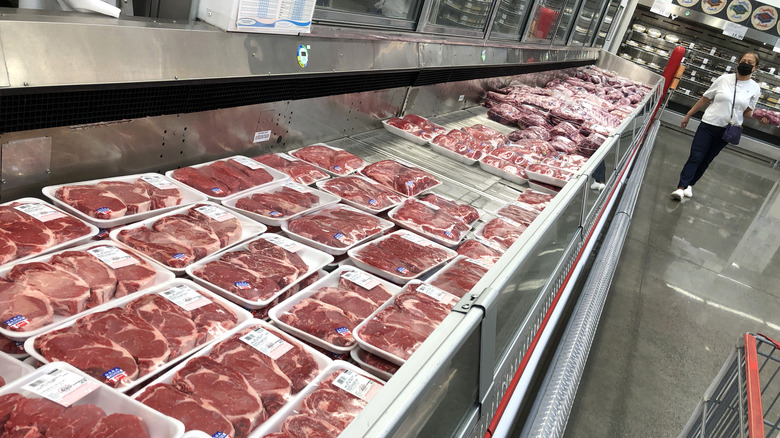Here's What You Need To Know To Buy Beef Tenderloin Like A Pro
Sourced from the loin of the cattle and renowned for its tenderness (hence the name), beef tenderloin is the cut of choice any time home chefs would like to whip up a slab of slow-cooked roast. And if you're ever in the mood for a steak dinner? A tenderloin can be sliced into the legendary filet mignon. Cook it on a grill for a few minutes and you'll have a delicious and decadent meal ready to go. But while it's undoubtedly delicious, it comes with a hefty price tag (it's one of the priciest beef cuts that you can get, in fact.) Depending on availability, grade, and trimming, you can expect to pay anywhere from $20 to $30 per pound.
If you're shelling out big bucks for it, you'll definitely want to make sure you're getting the best of the best. Fair warning, there'll be a lot of things that you have to look out for, from the grade and the cut to the trimming. It can be a bit intimidating at first, but with a bit of practice and the following tips, you'll become a pro at choosing and preparing this lovely cut of beef in no time.
If possible, go for USDA Prime beef
When you're shopping for beef tenderloin, especially the packaged kind found in the meat aisle at the supermarket, you'll typically find a USDA Grade sticker stuck to the front. What this sticker says indicates the flavor and quality of the meat. For the uninitiated, the lowdown on USDA Grade is this: Depending on several factors, like the marbling, juiciness, and the flavor of the beef, the USDA is going to give commercially sold beef one of three grades: Prime, Choice, and Select. (There are technically eight grades, but you'll only find those three for sale at the store — the other grades of beef are usually ground or used in processed products.)
The highest-quality beef is given the Prime grade. Because USDA Prime tenderloins come almost exclusively from young, well-fed cattle, they should have beautiful marbling (intramuscular fat) weaving all throughout their meat strands. When you cook it up, the fat will melt, coating your tongue with a very rich flavor. Of course, this quality will be reflected in the price tag. Prime tenderloins can cost you as much as $30 a pound, but all the juiciness and flavor that you get in return will be well worth it.
That doesn't mean Choice and Select tenderloins aren't worth buying, though. They definitely won't be as flavorful as Prime, but it's nothing that some extra seasoning or a good marinade can't fix.
Head or tail (or center?)
A whole beef tenderloin is a long, hefty strip of meat that can weigh around 6 pounds. A whole tenderloin can comfortably feed around eight to twelve people. For smaller gatherings or if you're planning on making a steak from your tenderloin, it's better to have it broken down. A beef tenderloin can be broken down into three major parts. First is the head, which, unlike what its name suggests, actually comes from the rear of the cattle. Looking at it, you'll find that it's much thicker and bigger than the other end (the tail.) This part can be cubed and skewered to make beef kebabs, or you can dice it up to set the stage for a pot of beef stew.
The center-cut, also known as chateaubriand, is the stretch of juicy meat that sits between the head and the tail, smack-dab in the center of the tenderloin. You can roast it or turn it into steak. At the other end of the tenderloin is the tail, which is closer to the neck of the cattle. Compared to the head, it's thinner and smaller, so it's used for making filet medallions (a smaller, but thicker version of a filet mignon.)
To trim or not to trim?
A beef tenderloin can be sold in one of two ways, either untrimmed or trimmed. Untrimmed means you'll still get all of the fat as well as the silver skin (a white-ish membrane that sticks to the tenderloin) still attached. It's the cheaper one between the two since the butcher doesn't have to work extra to cut out all these parts. Trimmed is the opposite. You'll get a tenderloin that's very "clean," with the marbling crisscrossing the red meat as the only sign of fat on the tenderloin.
People shell out extra to buy trimmed versions for a reason, though. The silver skin doesn't soften out when it's cooked and can cause the tenderloin to turn chewy, so it has to come off one way or another. Having it trimmed beforehand saves quite a lot of time and sweat. But if a trimmed beef tenderloin is a bit over your budget, just get the untrimmed one and cut out all the unwanted bits yourself. It's a great way to save some money in exchange for a bit of time and extra work.
Plan ahead for how much tenderloin to buy
Let's say you've picked out your perfect tenderloin, now the big question is how much of it should one buy? If you're planning to serve a large party with more than six attendees, a whole beef tenderloin is the way to go. But more often than not, you'd want just a cut of the tenderloin.
If the roast is the centerpiece of the table with few side dishes, plan to serve around 8 ounces of meat for each person. That might sound like a lot, but keep in mind that the tenderloin will shrink a bit during cooking. The extra will ensure that everyone gets enough on their plate. Got a bunch of side dishes that'll fill up everyone before the beef can be finished, or want to have some leftovers to stuff a loaf of bread for a roast beef sandwich tomorrow? If so, adjust that serving amount down to around 6 ounces per person.
So, for a dinner party with around six people (including yourself,) aim to buy around 2 ¼ to 3 pounds of tenderloin. That should give everyone a few nice, thick slices and maybe even a little extra just in case anyone's up for seconds.
Where to shop for beef tenderloin
If you want to save money on your beef tenderloin and have a membership to Costco or Sam's Club, you're in luck. You'll get plenty of good deals on beef tenderloin at these retailers. Untrimmed tenderloins can sometimes get as low as around $15 a pound at big-box stores. Plus, if you're planning to buy in bulk, you can save some serious cash.
On the other hand, if you want a more personalized experience or have any special requests, a butcher is the way to go. They can give you expert advice on picking out the perfect tenderloin and can even trim or cut it to your liking. Plus, many butchers get their meat from local farms, so you know it's fresh and you're supporting your community. However, be prepared to shell out more. A pound can easily run up to $35 or more, depending on the kind of cut that you're looking to buy.
At the end of the day, though, whether you opt for a big-box store or a butcher, just remember to look for a tenderloin with good color, consistent marbling, and a firm texture. The roast or steak that you've been planning to cook all week will come out juicy, packed to the brim with flavors, and melt-in-your-mouth tender every time!
